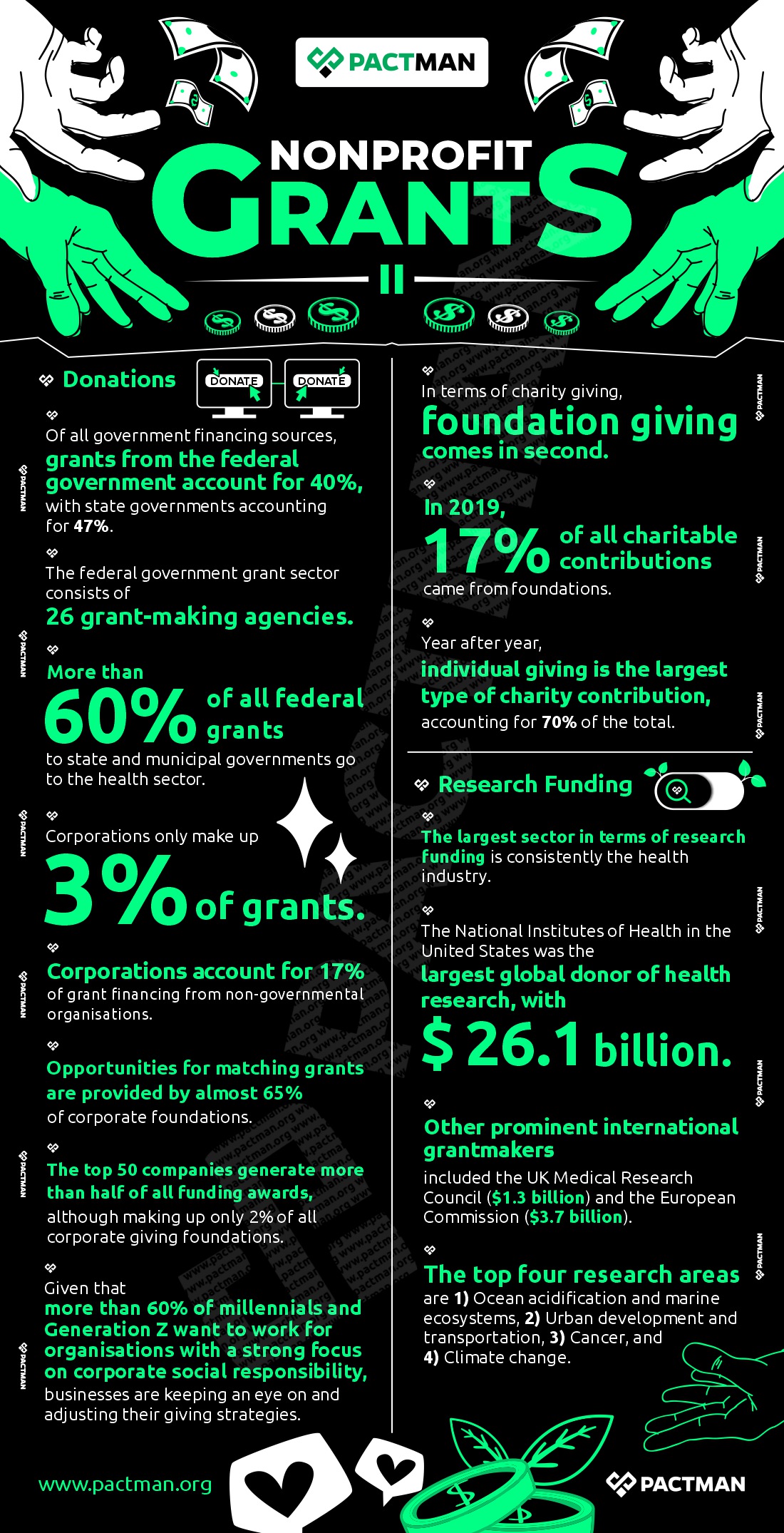I
Introduction
The fundamental question posed by donors, trustees, regulators, and taxpayers is “Can you prove that you are making a difference?” Over the years, this has drawn more attention to impact-related issues of nonprofit grants within the sector in the United States.

Throughout the past 20 years, nonprofit organisations have steadily moved to assess performance at every stage of the logic chain. This stage includes moving from inputs, activities, and outputs that are directly within their control to monitoring the wider effects and results of their work. Meanwhile, the government is looking more closely at organisations to prove their impact and increase public accountability.
Many state agencies create milestones and implement performance-based contracts with service providers, including nonprofit organisations, as part of larger initiatives. Also, there is a pronounced shift from the use of evaluation to measure the impact of past nonprofit grants. Now, organisations adopt a more timely and pragmatic process of gathering forward-looking information that will enable both grantors and grantees to make ongoing improvements in their work.
This article aims to provide some structure to the mechanisms through which nonprofit grants shape the competitive landscape of the sector. Also, we will consider the implications of nonprofit grants as we tour the many dimensions of the sector’s landscape.
II
Understanding Nonprofit Grants and their Processes
Using asymmetrical information and making decisions in the face of uncertainty, nonprofit grants comprise a competitive system of exchange. The demand side consists of a variety of nonprofit groups. By and large, these groups compete for scarce philanthropy resources by representing diverse needs and deserving initiatives. Foundations on the supply side are largely autonomous and have considerable latitude. Hence, they allocate funds based on their objectives and core principles.

All in all, a few grantees must be chosen for grant allocation since nonprofit demand usually outpaces the yearly supply of foundation grants. In this competitive sector, nonprofit managers and fundraisers may try to gain an advantage by emphasising their financial statistics. This is especially true with industry watchdog groups paying more attention to these metrics.
Even more, organisations in the social sector are under more pressure to focus on performance measurement. Fundamentally, this is a result of the increased emphasis on impact and accountability, both domestically and internationally. Here are the three questions, which many nonprofit administrators ask regularly:
- What elements of the logic chain—inputs, actions, outputs, consequences, or impacts—can my organisation quantitatively measure?
- What metrics must my organisation use to ensure that funders are held accountable?
- How can my organisation better accomplish its objective through measurement?
Deeper analytical issues that are prevalent in the social sector lie beneath these practical queries. Specifically, an organisation’s boundaries and operational strategy reflect its management control as well as its ability to gain nonprofit grants.
III
Critical Statistics on Nonprofit Grants
This section will consider the impact of nonprofit grants globally and how organisations leverage these funds.
a. Grant cycle/timeline
While conventional government grants may require up to or more than 100 hours to complete, foundation grants may just require 15 to 20 hours. Contrary to popular belief, the average success rate for grant writing is quite low. Some claim that only roughly 10% of grant bids are accepted.
Most grants, according to grant writers, take between one and six months from the time an application is submitted until the award is made. Furthermore, ⅓ of grant cycles last between one and three months, while ⅓ of grant cycles last between four and six months.

b. Grant writers
61% of all grant applicants, according to a Grant Station survey, depended on just one or two people to write and submit their grants. Only 8% of grant seekers are contracted grant writers, whereas 74% of grant seekers and writers are internal staff members of the application organisation. 92% of the more than 86,000 grantmaking organisations are autonomous.
c. Donations
Of all government financing sources, grants from the federal government account for 40%, with state governments accounting for 47%. The federal government grant sector consists of 26 grant-making agencies. Also, more than 60% of all federal grants to state and municipal governments go to the health sector.
Corporations only make up 3% of grants. Also, corporations account for 17% of grant financing from non-governmental organisations. Opportunities for matching grants are provided by almost 65% of corporate foundations. The top 50 companies generate more than half of all funding awards, although making up only 2% of all corporate giving foundations. Given that more than 60% of millennials and Generation Z want to work for organisations with a strong focus on corporate social responsibility, businesses are keeping an eye on and adjusting their giving strategies.

In terms of charity giving, foundation giving comes in second. In 2019, 17% of all charitable contributions came from foundations. Year after year, individual giving is the largest type of charity contribution, accounting for 70% of the total.
d. Research funding
The largest sector in terms of research funding is consistently the health industry. The National Institutes of Health in the United States was the largest global donor of health research, with $26.1 billion. Other prominent international grantmakers included the UK Medical Research Council ($1.3 billion) and the European Commission ($3.7 billion).
The top four research areas are: 1) Ocean acidification and marine ecosystems, 2) Urban development and transportation, 3) Cancer, and 4) Climate change.
e. Operating support
As of 2020, fewer than 32% of foundations offer their grantees general operating support. According to 29% of foundations, they offer any support beyond the grant itself. A meagre 18% offer funding for organisational effectiveness or capacity-building to the bulk of their grantees.
f. Donation tools
27% of donors claim that their giving to nonprofits has been impacted by technology.
IV
How Organisations Can Position Themselves for Grants
This section will consider how nonprofits can create a structure or system that positions them at an advantage to obtain grants.

1. Prioritise effective decision making
The decisions made by an organisation’s leaders must always take into account the particular opportunities and challenges that each one encounters. Nonprofits should have the readiness to face some fundamental, interconnected concerns head-on:
- For what outcomes will we hold ourselves responsible?
- What are we going to do to attain them?
- How can we pay for the outcomes, and how much will they cost?
- How can we create the kind of organisation required to produce outcomes?
When combined, these questions provide a framework that executive directors can utilise when having open discussions with stakeholders and when creating detailed, realistic strategies for really changing things. The questions may appear straightforward and general, but for a variety of reasons, responding to them and implementing the suggestions is quite challenging.
Oftentimes, the factors that drive the nonprofit sector make it harder for its organisations to concentrate on results, even if there is increasing demand to do so.
2. Missions should have an intended impact
For businesses, market forces act as feedback mechanisms. Customers and investors reward successful businesses while underperforming ones face penalties. Using metrics like ROI, quarterly earnings, customer loyalty scores, and the like, performance is very simple to measure.
However, for nonprofits, the main factors drawing vital resources are missions rather than markets. These include donors who are motivated by the organisations’ ambitious objectives, board members who not only donate their time and expertise but also frequently act as significant funders, and employees who take modest salaries to carry out work they are passionate about.
All in all, missions are usually more effective in inspiring than directing. Therefore, it is not unusual for important stakeholders to adopt strongly held yet different opinions about what the organisation’s top priorities should be. These disagreements are often concealed by the mission statement’s overarching goals.
Determining the outcomes a nonprofit must achieve to succeed is the most important—and possibly most challenging—decision it can make. This process involves converting the organisation’s mission into goals that are both clear enough to guide resource allocations and compelling enough to garner sustained support from stakeholders.
One strategy is for leaders of nonprofit organisations to define and reach a consensus on what we refer to as its desired impact. Both the beneficiaries of a nonprofit’s operations and the benefits the organisation will offer are identified in a well-intended impact statement. When decision-makers must choose between conflicting, worthwhile agendas, this level of precision provides them with a useful lens to use. Also, an intended impact statement can take many forms, but it always includes evidence, organisational principles, and a readiness to make difficult choices.
3. Board members must be active
Numerous articles have examined how the nonprofit organisation’s board of directors and executive staff interact as a result of its increased reliance on nonprofit grants. Two literary streams appear to stand in stark contrast to one another. According to some, the board offers guidance in crucial areas like managing finances and ties with the foundation or government. However, some contend that nonprofit boards play a minor role in the contracting process and that their duties and makeup reflect the negative effects of relying on grants or government funding.
In essence, they contend that to provide financial resources for the future, the board’s role becomes crucial. The board must handle the strategic projections and the partnerships with these organisations. Also, boards could represent the community better to be seen as more legitimate.
Nonprofit boards may be primarily composed of corporate, professional, and social elites – who are more likely to have linkages with funding agencies, as well as expertise in grant writing. Oftentimes, boards of highly supported nonprofits are typically composed of businesses rather than community representatives, making them more professional.
V
How to Measure the Impact of Nonprofit Grants
It is generally accepted in the social sector that outcomes and consequences should be measured as far down the logic chain as feasible. Consequently, groups addressing social issues should be able to show that they have an impact on resolving societal issues, particularly if they are looking for public support.

However, it is worthwhile to evaluate if and to what extent such measurement is appropriate for all organisations in the social sector. Below is a rough typology of the nonprofit sector in the field of poverty alleviation that separates at least three major categories of activities.
- Emergency assistance: This includes catastrophe, crisis, and conflict mitigation as well as actions that provide immediate life necessities like food and temporary housing.
- Service delivery: Efforts to provide for necessities like healthcare, education, long-term housing, community development, jobs, and revenue-generating.
- Policy and rights advocacy: These are initiatives that tackle systemic problems in public policy and regulation, rights, and social norms.
Examples
A few instances might be useful for demonstration. The Red Cross, Doctors Without Borders, Oxfam America, CARE USA, and many other foreign NGOs, for example, are involved in emergency relief efforts. Measuring the disaster relief efforts of these groups is conceptually very simple. Firstly, measure the number of persons supported as well as the delivery of emergency supplies such as food, water, tents, and medical clinics.
As can be seen, emergency relief is commonly quantified in terms of inputs, activities, and results. Although it is an intricate process that calls for extremely advanced coordination and supply chain management skills, its primary goal is to address immediate survival demands rather than long-term development objectives or repercussions.
In addition, a large number of these same groups are involved in post-emergency community development and service delivery, which is often quantified in terms of outputs. This includes the quantity of children and their families who receive drinking water, education, health care, and other necessities. When donors are curious about the use of their funds, this information is easily provided.
Outcome Assessment
Conversely, outcome assessment necessitates responses to a more intricate causal query: Do the actions and results result in longer-term advantages? Given that organisations have the most control over their immediate actions and outputs, consequences transcend organisational boundaries. Hence, it is difficult to understand how outcomes may be quantified or even predicted in the absence of a causal explanation that connects the several factors that potentially influence outcomes.
Immunisation is an often-used example of tying outputs to results. For example, the number of individuals immunised against polio is a crucial output measure of an immunisation campaign. These initial observations lead to several propositions that relate performance measurement to the type of social sector activity:
1. Performance in emergency and relief work can be measured in terms of inputs, activities, and outputs.
2. Performance in service delivery work can be measured in terms of activities and outputs.
Despite the importance of every person immunised, the most significant impacts are only achieved once a certain threshold of immunisation is reached, say 80% to 85% of a population, as this makes it possible for the disease to be eradicated. Eradication is not just an outcome, but an impact, and the logistics of such a feat are extremely complex.
3. When it comes to large-scale and scope service delivery, performance can be evaluated in terms of results and occasionally repercussions.
4. Outcomes and influence, an intermediate result, can be used to gauge performance in advocacy and rights-based activity.
VI
How to Align Measurement Systems with Strategy
Lastly, there is a significant information vacuum about management control systems in the nonprofit sector. Specifically, this is regarding how to match strategy and mission with performance systems. With a few noteworthy exceptions, there hasn’t been much work done from the standpoint of developing applied knowledge for managerial objectives.

Although the control issues that managers face in nonprofit and for-profit organisations seem to be similar on the surface—lack of ability, lack of motivation, and lack of direction—the solutions must inevitably differ because the goals and outcomes are typically more ambiguous in the social sector. Also, managers have a harder time using financial incentives to motivate behaviour.
Many questions that are pertinent to the social sector include:
- What are some effective ways for managers to employ core values as a lever of control?
- How can supervisors interact with their employees, provide incentives, and keep an eye on important performance metrics?
- Furthermore, which interactive systems and organisational learning methodologies are best suited for enhancing social performance?
Now more than ever, a wealth of research opportunities are presented by recent developments in the social sector. This is especially true in the areas of adaptive learning and participatory governance in major global NGOs and social movements. In summary, the fundamental problem in the social sector is twofold:
- Figuring out how to create performance and control mechanisms that facilitate and support this alignment, and
- Figuring out what an alignment of goal and strategy might look like.
Examples
For example, there is evidence to suggest that the effectiveness of immunization campaigns may not proceed in the same straight line as many donors and international health organisations had expected. The recurrence of polio cases in nations believed to have eradicated the disease has hampered efforts to eradicate it, for instance, using a “vertical” strategy of vaccination programs.
Global players like the Bill and Melinda Gates Foundation are increasingly thinking about integrating vaccination efforts with “horizontal” tactics like bolstering the fundamental health services and systems in developing nations. Less is known about the causal reasoning behind this combined vertical-horizontal approach. However, it stems from the worry that many diseases may resurface in the absence of a more comprehensive system of effective health, hygiene, and sanitation services for the impoverished.
Conclusion
There is increasing pressure on nonprofit sector leaders to show how their work affects urgent societal issues like world poverty. At the same time, these organisations are under increasing pressure from their boards, employees, and private and public contributors to demonstrate results. Now more than ever, foundations must prioritise quantifying the benefits of their grantmaking and consider their giving more strategically. This is especially significant with the rising discussions on impact measurement which have taken centre stage in the world of philanthropy.


